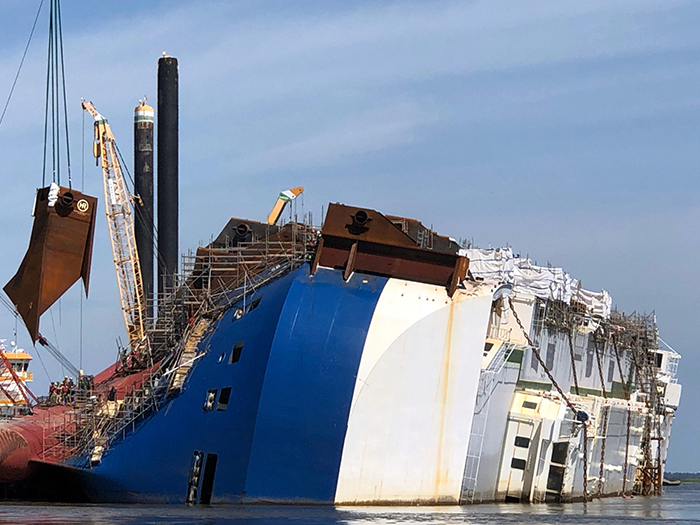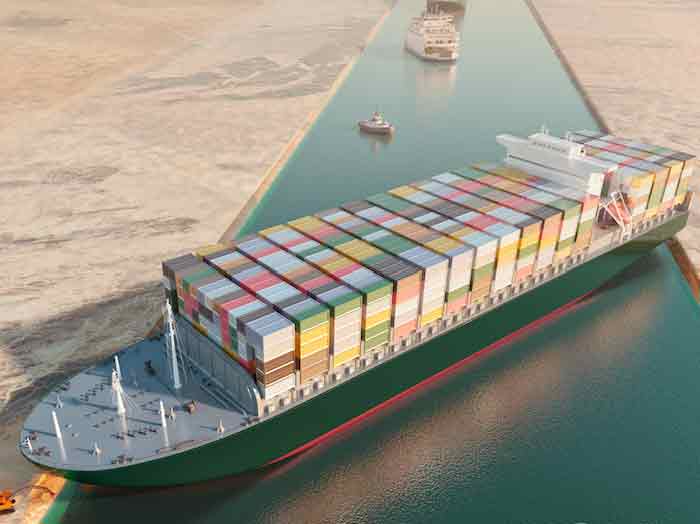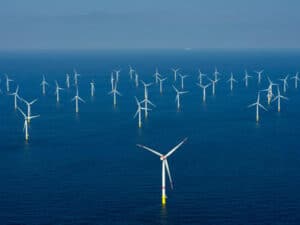
Vessel total losses still low, but …
Written by Nick Blenkey
Removal of Golden Ray wreck has cost “several hundreds of millions of dollars,” says insurer Allianz. [St. Simons Sound Incident Response Photo]
There’s good news and bad news in the latest annual Safety & Shipping Review from insurer Allianz Global Corporate & Specialty SE (AGCS). The good news is that international shipping industry continued its long-term positive safety trend over the past year, with the number of large vessels lost remaining at record low levels in 2020, with reported incidents declining year-on-year.
The not-so-good news? Despite the low level of losses, “it is not all smooth sailing,” says Capt. Rahul Khanna, Global Head of Marine Risk Consulting at AGCS. “The ongoing crew crisis, the increasing number of issues posed by larger vessels, growing concerns around supply chain delays and disruptions, as well as complying with environmental targets, bring significant risk management challenges for ship owners and their crews.”
LOSSES AND CASUALTIES
The annual AGCS study analyzes reported shipping losses and casualties (incidents) over 100 gross tons. During 2020, 49 total losses of vessels were reported globally, similar to a year earlier (48) and the second lowest total this century. This represents a 50% decline over 10 years (98 in 2011). The number of shipping incidents declined from 2,818 to 2,703 in 2020 (by 4%). There have been more than 870 shipping losses over the past decade.
The South China, Indochina, Indonesia and Philippines maritime region remains the global loss hotspot, accounting for one in every three losses in 2020 (16) with incidents up year-on-year. Cargo ships (18) account for more than a third of vessels lost in the past year and 40% of total losses over the past decade. Foundering (sunk/submerged) was the main cause of total losses over the past year, accounting for one in two vessels.
- Machinery damage/failure was the top cause of shipping incidents globally, accounting for 40%.
NO REDUCTION IN CLAIMS
Despite lower the total losses, the sector has not been spared significant claims activity.
“Overall, the frequency of marine claims has not reduced. We are also seeing an increased cost of hull and machinery claims due to delays in the manufacture and delivery of spare parts, as well as a squeeze on available shipyard space,” says Justus Heinrich, Global Product Leader, Marine Hull, at AGCS. “Costs associated with salvage and repairs have also increased.”
In future, warns AGCS, insurers could potentially see an uptick in machinery breakdown claims if COVID-19 has affected crews’ ability to carry out maintenance or follow manufacturers’ protocols.
LARGER VESSELS, LARGER EXPOSURES
The blocking of the Suez Canal by the Ever Given containership in March 2021 is the latest in a growing list of incidents involving large vessels or mega-ships. Ships have become ever-larger as shipping companies seek economies of scale and fuel efficiency.

“Larger vessels present unique risks. Responding to incidents is more complex and expensive. Approach channels to existing ports may have been dredged deeper and berths and wharfs extended to accommodate large vessels but the overall size of ports has remained the same. As a result, a ‘miss’ can turn into a ‘hit’ more often for the ultra-large container vessels,” says Capt. Nitin Chopra, Senior Marine Risk Consultant at AGCS.
“If the Ever Given had not been freed, salvage would have required the lengthy process of unloading some 18,000 containers, requiring specialist cranes. The wreck removal of the large car carrier, Golden Ray, which capsized in U.S. waters in 2019 with more than 4,000 vehicles on it has taken over a year and a half and cost “several hundreds of millions of dollars,” says AGCS.
FIRES, CONTAINER LOSSES
The number of fires on board large vessels has increased significantly in recent years. There was a record 40 cargo-related fires alone in 2019. Across all vessel types, the number of fires/explosions resulting in total losses increased again in 2020, hitting a four-year high of 10. Fires often start in containers, which can be the result of non-/mis-declaration of hazardous cargo, such as chemicals and batteries. When mis-declared, these might be improperly packed and stowed on board, which can result in ignition and/or complicate detection and firefighting. Major incidents have shown container fires can easily get out of control and result in the crew abandoning the vessel on safety grounds, thus increasing the size of loss.
Loss of containers at sea also spiked last year (over 3,000) and have continued at a high level in 2021, disrupting supply chains and posing a potential pollution and navigation risk. The number lost is the worst in seven years. Larger vessels, more extreme weather, a surge in freight rates and mis-declared cargo weights (leading to container stack collapse), as well as the surge in demand for consumer goods may all be contributing to this increase. There are growing questions about how containers are secured on board ships.
There’s much more in the full report. Download it HERE.




